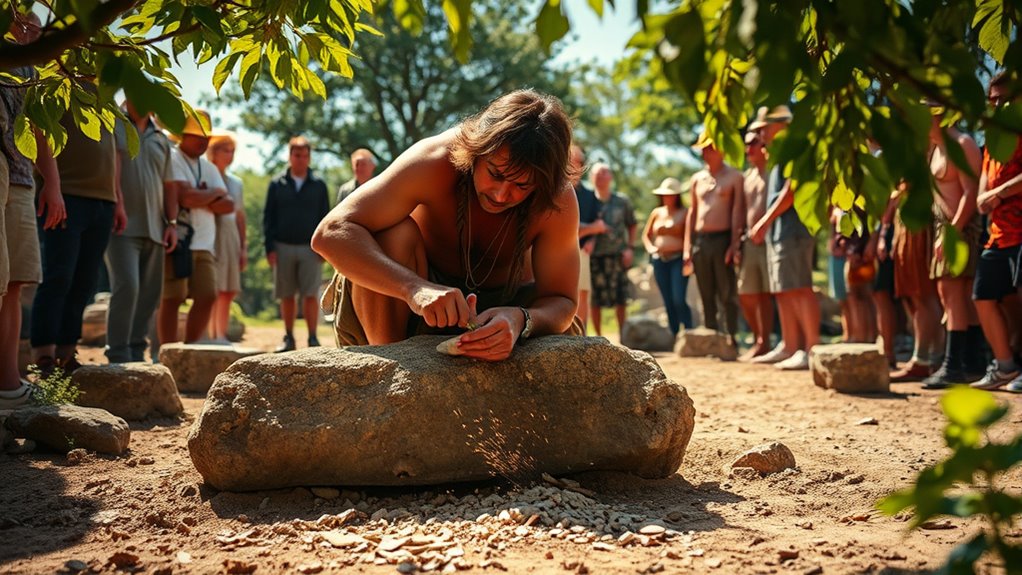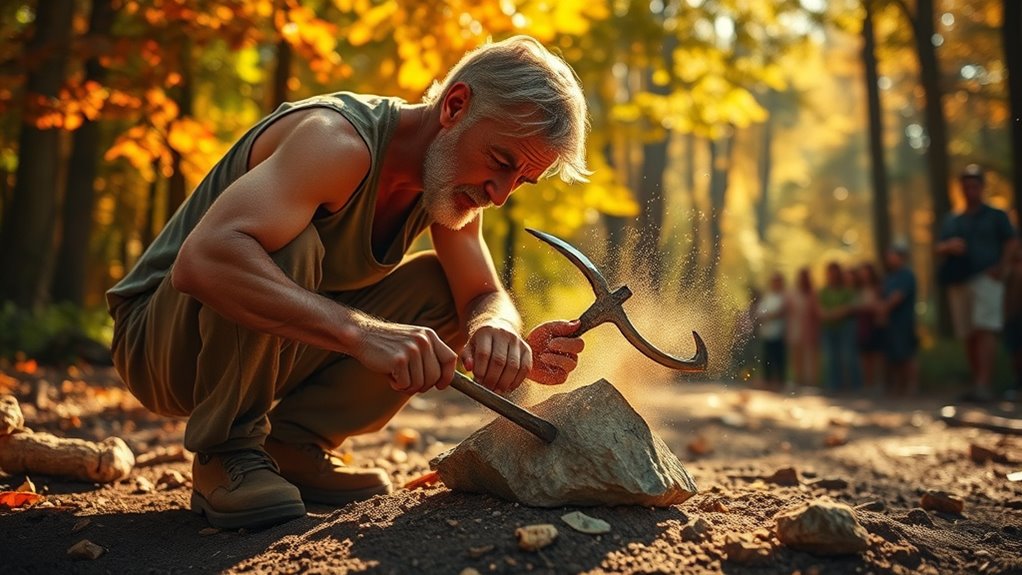At the Survival Expo, you’ll witness stone tool crafting come alive as ancient techniques enhance your survival skills. You’ll get hands-on experience in flintknapping, learning to create functional tools using various stones like flint and obsidian. Skilled experts will guide you through methods like percussion and soft hammer techniques. Each material’s unique qualities influence your crafting success. This not only equips you for wilderness challenges but also connects you to rich historical traditions. There’s more to discover!
Key Takeaways
- The Survival Expo featured live demonstrations of stone tool crafting, highlighting ancient skills essential for modern survival.
- Experts showcased flintknapping techniques, including percussion and soft hammer methods, for creating functional tools.
- Participants engaged in hands-on workshops, practicing stone tool crafting and learning about material selection and safety precautions.
- The historical significance of stone tools was emphasized, illustrating their role in hunting, food prep, and shelter construction.
- Attendees gained insights into the evolution of flintknapping techniques and cultural exchanges that shaped regional practices.

At the Survival Expo, stone tool crafting comes alive, showcasing ancient skills that are still pertinent today. You’ll discover the fascinating world of flintknapping, where artisans strike stone to remove flakes and create functional tools like spear points and knives. This hands-on experience not only connects you to our ancestors but also highlights the significance of these skills in survival scenarios.
As you participate, you’ll learn about several techniques used in crafting stone tools. The percussion method is one of the most basic, where a hammer strikes the stone core to dislodge flakes. You might also see the indirect percussion technique, which involves using a punch for precision flaking. If you’re aiming for thinner, sharper edges, the soft hammer technique, employing materials such as antlers, is your go-to. Grinding and polishing techniques further refine edges, ensuring your tools are as effective as possible.
Core preparation is another essential aspect of flintknapping. You’ll get a chance to see the Levalloisian method in action, a technique that allows for efficient flake removal. As you investigate deeper, you’ll appreciate the variety of natural materials used, like flint, obsidian, chert, basalt, and quartz. Each stone offers unique properties that influence the tool’s effectiveness, with flint prized for its ability to fracture cleanly.
The historical significance of these techniques becomes apparent as you explore their role in prehistoric life. Stone tools weren’t just implements; they were crucial for survival, from hunting to food preparation and even shelter construction. You’ll hear stories of how these skills evolved over thousands of years and how cultural exchanges shaped regional techniques.
At the Expo, hands-on workshops allow you to practice these skills yourself. You’ll gain insights from experts who share the historical and cultural significance of stone tools while guiding you in selecting appropriate materials. Safety precautions are emphasized, ensuring you feel secure while experimenting with flintknapping.
Ultimately, stone tool crafting at the Survival Expo isn’t just about ancient history; it’s about practical applications for modern survival skills. Understanding and mastering these techniques can empower you in wilderness settings, making you more self-reliant and resourceful. Embrace the challenge, and you might just find that the art of stone tool crafting is as pertinent today as it was for our ancestors.
Frequently Asked Questions
What Materials Are Best for Stone Tool Crafting?
When crafting stone tools, you’ll want to contemplate materials like flint for its durable edge, or chert, known for its excellent fracturing properties.
Obsidian is perfect for sharp arrowheads, while jasper offers a fine grain.
For grinding tools, granite works well, though it’s not suitable for chipping.
If you need axes, basalt is your best bet.
Choosing the right material considerably impacts your tool’s effectiveness and longevity.
Can Stone Tools Be Used for Modern Survival Situations?
Imagine standing in the wild, surrounded by nature’s raw beauty, a stone tool in hand.
Yes, stone tools can absolutely be used in modern survival situations. They’re versatile for cutting, scraping, and preparing food, fulfilling your basic needs.
When emergencies strike, these tools become your lifeline. With practice, you’ll master their use, tapping into ancient techniques that still resonate today, proving that sometimes, the simplest tools can be the most effective.
How Long Does It Take to Make a Stone Tool?
Making a stone tool can take anywhere from a few minutes to several hours, depending on your skill level and the tool’s complexity.
If you’re experienced, you’ll likely craft tools faster than someone just starting out. The technique you use also plays a big role; some methods are more efficient than others.
Are There Safety Precautions for Stone Tool Crafting?
What’s more important than your safety while crafting stone tools? You need to wear safety glasses to protect your eyes and gloves to shield your hands from cuts.
Don’t forget sturdy work boots to prevent foot injuries. Keep your workspace clear and well-lit, and guarantee proper ventilation to avoid dust inhalation.
Regularly maintain your tools and follow safety instructions closely. With these precautions, you can craft effectively and safely.
Where Can I Learn More About Stone Tool Crafting?
If you’re looking to learn more about stone tool crafting, consider checking out resources like the Stone Tools Museum for historical insights and techniques.
YouTube offers many video tutorials, while platforms like MasterClass provide detailed flintknapping guides.
You could also join practical workshops hosted by local historical societies or attend outdoor skills events.
Engaging in online forums allows you to connect with enthusiasts who share valuable tips and knowledge on crafting stone tools.
Conclusion
As you leave the Survival Expo, the experience of crafting stone tools lingers like the sharp edge of a freshly knapped flint. You’ve not only gained practical skills but also a deeper connection to our ancestors and the resilience of human ingenuity. With each strike of rock against rock, you’ve forged a bond with nature that empowers you to face the wild ahead. Remember, every tool you create is a step closer to mastering survival in a modern wilderness.










